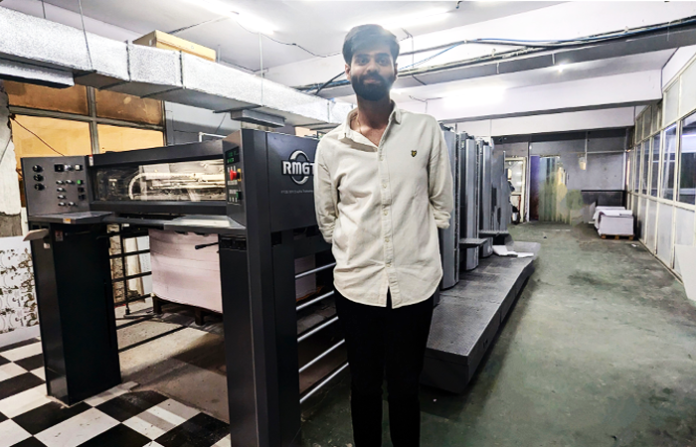
First Impression, an offset commercial printer based in Noida, recently expanded its machine portfolio with a new RMGT 920ST- 4 color sheetfed press — its first acquisition from the Japanese printing solutions provider. The press joins the printer’s existing lineup, which includes second-hand presses from Heidelberg and two brand-new presses from Komori.
According to Dhruv Goel, director of First Impression, the decision to invest in the RMGT press was driven by its cost-effectiveness and reputation for delivering quality output. The press has a maximum printing speed of 16,200 sheets per hour and can handle a sheet size from 290mm x 410mm to 640mm x 920mm, he explained.
First Impression is a one-stop solution for all types of commercial printing work, providing complete in-house printing services from prepress, printing, finishing, and binding. The printer has made significant strides after its second-generation joined the family business as a second-generation printer in 2021. Since Dhruv Goel’s active participation in the company’s operations, it has expanded its range of products and customers and doubled its capacity.
Goel pointed out that 80% of the company’s printing work is dedicated to book printing. The remaining 20% goes to commercial printing work such as flyers, brochures and calendars.
Like many other commercial printers, First Impression has experienced a shift toward book printing, driven by the decline in demand for commercial printing including advertising collateral with the onset of digital me together with the impact of the Covid pandemic.
“Although digital was slowly capturing the market even before Covid, the pandemic led to a faster decline in pamphlets, brochures, and other commercial printing. Book printing was also a concern during Covid, but it regained its market share, unlike other commercial print.” To make a point, he compared the amount of printed materials typically received while opening a bank account in the past versus today’s app based documentation and approval, indicating a significant reduction in the consumption of printing material.
Book printing, a seasonal business
Nevertheless, Goel noted that book printing is seasonal, with schools accounting for a significant portion of the business. The peak season for book printing begins in October and lasts until March. Work for his company comes substantially from reputed publishers.“We experience a surge in demand and workload every year in this period. Work is increasing every year.”
Despite the rise of eBooks, Goel emphasized that the urge to read physical books remains strong and is unlikely to diminish anytime soon. He says the preference for physical books will continue to drive the growth of book printing jobs which he feels is a thriving segment of the industry.
With numerous printers in the market, he feels the printing industry is a challenging and often thankless business. Customers now have many options to choose from, making it essential for printers to constantly strive for excellence at competitive prices. “In the Indian market, the importance of quality is high, but the price often takes the upper hand.”
Goel envisions the future of First Impression in digital printing, However, he emphasizes the need for thorough research and expertise before venturing into the digital print domain.















